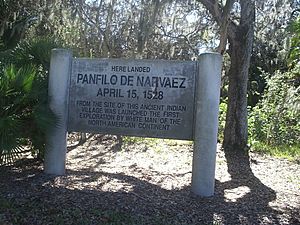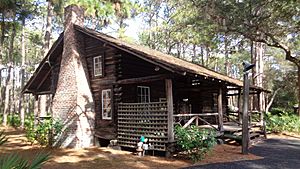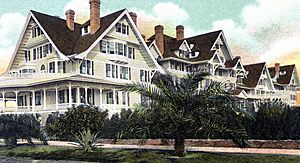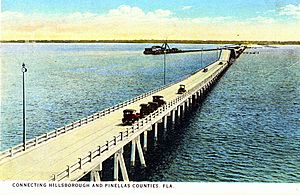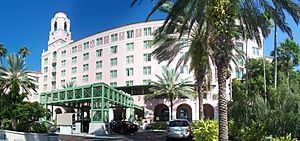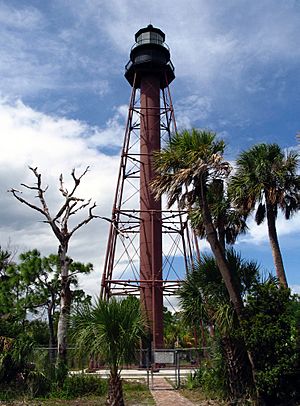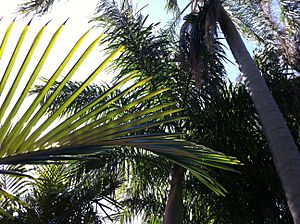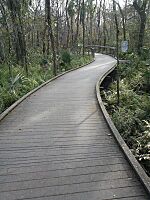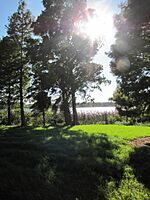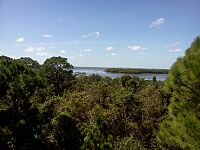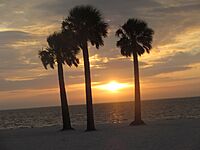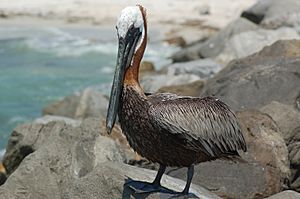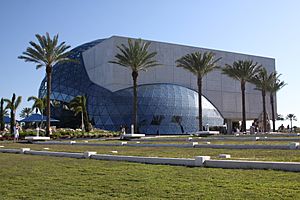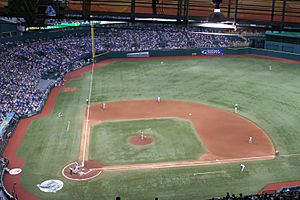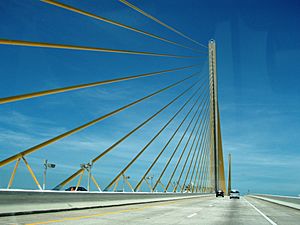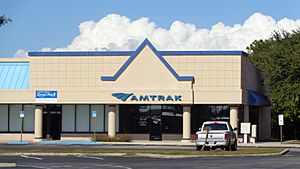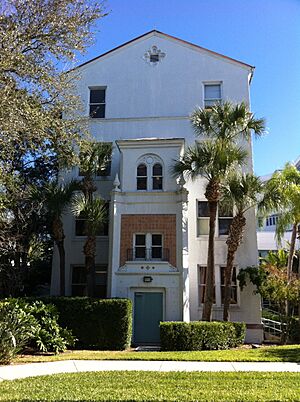Pinellas County, Florida facts for kids
Quick facts for kids
Pinellas County
|
||
|---|---|---|

|
||
|
||
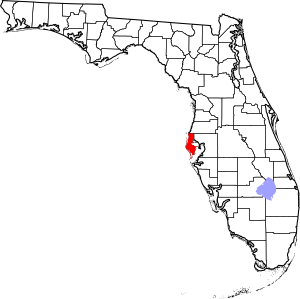
Location within the U.S. state of Florida
|
||
 Florida's location within the U.S. |
||
| Country | ||
| State | ||
| Founded | January 1, 1912 | |
| Named for | Spanish Punta Piñal ("Point of Pines") | |
| Seat | Clearwater | |
| Largest city | St. Petersburg | |
| Area | ||
| • Total | 608 sq mi (1,570 km2) | |
| • Land | 274 sq mi (710 km2) | |
| • Water | 334 sq mi (870 km2) 55.0%% | |
| Population
(2020)
|
||
| • Total | 959,107 | |
| • Estimate
(2023)
|
||
| • Density | 3,491/sq mi (1,348/km2) | |
| Time zone | UTC−5 (Eastern) | |
| • Summer (DST) | UTC−4 (EDT) | |
| Congressional districts | 13th, 14th | |
Pinellas County (say "pih-NEL-əss") is on the west coast of Florida. In 2020, about 959,107 people lived here. This makes it the seventh-biggest county in Florida by population. It's also the most crowded county in Florida. About 3,491 people live in each square mile.
Pinellas County is part of the larger Tampa Bay area. Clearwater is the main city where the county government is. St. Petersburg is the biggest city in the county. It's also the largest city in Florida that isn't a county seat.
Contents
- Exploring Pinellas County's Past
- Geography and Nature in Pinellas County
- Ecosystems and Wildlife
- Pinellas County's Climate
- People and Communities
- Education in Pinellas County
- Pinellas County's Economy
- Culture and Fun in Pinellas County
- Sports and Recreation
- Media and News
- Transportation in Pinellas County
- Emergency Services
- Communities in Pinellas County
- See also
Exploring Pinellas County's Past
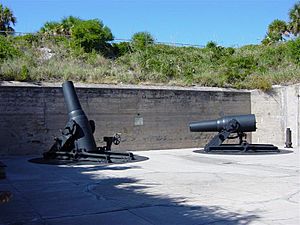
Life Before Europeans Arrived
When Europeans first came to the Pinellas area, the Tampa Bay area was home to people of the Safety Harbor culture. These people lived in groups called chiefdoms. One important group was the Tocobaga. They had a town and a large temple mound overlooking the bay in what is now Safety Harbor. You can still visit this ancient site today at Philippe Park.
Spanish and British Rule in Florida
In the early 1500s, Spanish explorers found and began to explore Florida. This included Tampa Bay. In 1528, Pánfilo de Narváez landed in Pinellas. Ten years later, Hernando de Soto also explored the area.
By the early 1700s, the Tocobaga people were almost gone. They got sick from European diseases. They also suffered from European conflicts. Later, Spanish explorers named the area Punta Piñal. This means "Point of Pines" in Spanish. Florida was traded between the British and Spanish many times. Finally, Spain gave Florida to the United States in 1821. In 1823, the U.S. Army built Fort Brooke (which later became Tampa).
Early Settlements in West Hillsborough
In 1834, much of west central Florida became Hillsborough County. This included the Pinellas area, then called West Hillsborough. The very next year, Odet Philippe became the first non-native person to live here permanently. He started a farm near the Tocobaga village in Safety Harbor. Philippe was the first to bring citrus farming and cigar-making to Florida.
Around the same time, the U.S. Army built Fort Harrison. It was a rest stop for soldiers from Fort Brooke. The fort was on a high spot overlooking "Clear Water Harbor." This area later became part of Clearwater. Clearwater became the first organized community on the peninsula. It also had the first post office.
The Armed Occupation Act of 1842 encouraged more people to move to Pinellas. It offered 160 acres of land to anyone who would farm it and help defend it. Pioneer families like the Booths and McMullens started farms. They planted more citrus trees and raised cattle. During the American Civil War, many residents fought for the Confederate States of America. The area itself was not very important during the war.
On September 27, 1848, a strong hurricane hit Florida's west coast. It created a new waterway called John's Pass. John Levique discovered it and named it after himself.
Tarpon Springs became the first official city in West Hillsborough in 1887. In 1888, the Orange Belt Railway reached the southern part of the area. The railroad owner, Peter Demens, named the town that grew there St. Petersburg. He named it after his hometown in Russia. St. Petersburg became a city in 1892. Other cities that grew during this time were Clearwater (1891), Dunedin (1899), and Largo (1905).
Construction of Fort De Soto began in 1898. It was built on Mullet Key to protect Tampa Bay during the Spanish–American War. The fort had artillery and mortar guns.
The Birth of Pinellas County
In the early 1900s, West Hillsborough had no paved roads. Traveling to the county seat in Tampa was very hard. It often took an overnight trip. People in Pinellas felt ignored by the county government. They decided to create their own county. On January 1, 1912, Pinellas County was officially formed. The peninsula and a small part of the mainland became the new county.
Land Boom and Prohibition Era
Aviation history was made in St. Petersburg on January 1, 1914. Tony Jannus made the world's first scheduled commercial airline flight. He flew from St. Petersburg to Tampa. The popular concert place Jannus Live in St. Petersburg is named after this flight.
The early 1920s brought a big land boom to Florida, including Pinellas. Cities borrowed a lot of money to build roads and bridges. The Gandy Bridge opened in 1924, cutting travel time to Tampa in half. It was the longest car toll bridge in the world at that time.
Prohibition made alcohol illegal. But it was not popular in Pinellas. People called "rum-runners" brought liquor from Cuba using the county's inlets and islands. Others made their own alcohol in the woods.
The Great Depression and World War II
The Great Depression hit Pinellas early, in 1926. This was when the real estate boom ended. Local businesses struggled. St. Petersburg couldn't pay its debts by 1930. Growth didn't return until after World War II.
During the war, tourism stopped. But thousands of soldiers came to the area for training. Hotels became army barracks. The Vinoy Park Hotel was used as an Army training school. Women and girls in the area also helped with the war effort. They formed a group called the Bomb-a-Dears. They held dances, socialized with soldiers, and sold war bonds. After the war, many soldiers remembered their time in Pinellas. They returned as tourists or to live there.
Pinellas County's Recent History
After World War II, Pinellas grew very fast. In 1954, the first Sunshine Skyway Bridge opened. It replaced an old ferry service. By 1957, Clearwater was America's fastest-growing city.
A sad event happened on May 9, 1980. A ship hit the Sunshine Skyway Bridge during a storm. Over 1,200 feet of the bridge fell into Tampa Bay. Seven cars and a bus fell 150 feet into the water. Thirty-five people died. A new bridge opened in 1987. It has been named one of the "Top 10 Bridges" in the World.
The county has a 21-acre living history museum called Heritage Village. It has over 28 old buildings, some from the 1800s. Visitors can see what life was like long ago in Pinellas.
Pinellas County celebrated its 100th birthday on January 1, 2012.
Geography and Nature in Pinellas County

Pinellas County covers about 608 square miles. About 274 square miles are land, and 334 square miles (55%) are water. It's the second-smallest county in Florida by land area. Pinellas is a peninsula. The Gulf of Mexico is to the west, and Tampa Bay is to the south and east. It is 38 miles long and 15 miles wide at its widest point. It has 587 miles of coastline.
Physical Features of Pinellas
The land in Pinellas County ranges from sea level to 110 feet high. The highest point is near Clearwater. Because it's a small county with many people, most of the land is already developed. But the county has kept many parks and nature areas. These places let people enjoy nature and see what the area looked like long ago.
Underneath Pinellas are layers of limestone rock. This rock is like a sponge and holds a lot of water. A ridge of limestone runs down the middle of the county.
The county has 35 miles of beaches and sand dunes. These are on 11 barrier islands. These islands protect the land from storms. They also help the tourism industry. The islands are always changing due to waves. Hurricanes have also changed the islands a lot. For example, the 1848 hurricane created John's Pass. A 1921 hurricane created Hurricane Pass.
Between the barrier islands and the main land are several bodies of water. These include St. Joseph Sound, Clearwater Harbor, and Boca Ciega Bay. A narrow stretch of water called The Narrows connects Clearwater Harbor to Boca Ciega Bay.
Long Bayou separates Seminole from St. Petersburg. Part of Long Bayou was sealed off to create Lake Seminole. The Cross Bayou Canal goes across the peninsula. It flows through Pinellas Park and into Tampa Bay.
Barrier Islands and Waterways
- Anclote Key: This island is off the coast of Tarpon Springs. It is the northernmost point in the county.
- Howard Park: A beach made by people in the 1960s.
- Three Rooker Bar: This is the newest of Pinellas' barrier islands.
- Honeymoon Island
- Hurricane Pass
- Caladesi Island
- Dunedin Pass: This pass closed in the 1980s, connecting Caladesi Island and Clearwater Beach.
- Clearwater Beach
- Clearwater Pass
- Sand Key: This is the longest barrier island in Pinellas.
- John's Pass
- Treasure Island
- Blind Pass
- Long Key (St. Pete Beach)
- Pass-a-Grille Channel
- Shell Key
- Tierra Verde: This area connects the mainland to Fort De Soto. It was made by joining smaller islands.
- Bunces Pass
- Mullet Key: This island is home to Fort De Soto. It is the southernmost point in the county.
Protected Natural Areas
- Pinellas National Wildlife Refuge
- Honeymoon Island State Park
- Caladesi Island State Park
- Anclote Key Preserve State Park
Pinellas County Parks and Preserves
Pinellas County has many parks and preserves for everyone to enjoy:
- A.L. Anderson Park, Tarpon Springs
- Boca Ciega Millenium Park, Seminole
- John Chesnut Sr. Park, Palm Harbor
- Eagle Lake Park, Largo
- Fort De Soto Park, Tierra Verde
- Fred Howard Park, Tarpon Springs
- Lake Seminole Park, Seminole
- Philippe Park, Safety Harbor
- Ridgecrest Park, Largo
- Sand Key Park, Clearwater
- Sawgrass Lake Park, St. Petersburg
- John S. Taylor Park, Largo
- Wall Springs Park, Palm Harbor
- Walsingham Park, Largo
- War Veterans Memorial Park, St. Petersburg
- Brooker Creek Preserve
- Mobbly Bayou Preserve
- Shell Key Preserve
- Weedon Island Preserve
Pinellas County Parks Gallery
Other Nature Spots
Boyd Hill Nature Preserve: This 245-acre park is in St. Petersburg. It has a nature center and over three miles of trails. You can see different ecosystems here.
Neighboring Counties
- Pasco County is to the north.
- Hillsborough County is to the east and south.
Hillsborough County also extends into the Gulf of Mexico. It separates Pinellas County from Manatee County.
Ecosystems and Wildlife
Plant Life in Pinellas
Pinellas County has many different natural areas. These include:
- Freshwater wetlands with bald cypresses and ferns.
- Coastal mangrove swamps.
- Small forests called hardwood hammocks with laurel oaks, live oaks, cabbage palms, and southern magnolias.
- Wet pine flatwoods with longleaf pines and saw palmettos.
- Dry, high sandhills with longleaf pines and turkey oaks.
- Sand pine scrub areas with sand pines, saw palmettos, and various oaks.
Offshore, you can find the Tampa Bay estuary (where fresh and salt water mix). There are also many seagrass beds in the gulf. The county has also built several artificial reefs to help sea life.
Animal Life in Pinellas
Many types of birds live in Pinellas or visit in winter. These include:
- Wading birds like great blue herons, egrets, white ibises, and roseate spoonbills.
- Water birds like brown pelicans, white pelicans, and cormorants.
- Many types of shorebirds.
- Common birds like seagulls and songbirds such as blue jays, mockingbirds, and crows.
- Ospreys are common birds of prey. Other birds of prey include turkey vultures, red tailed hawks, great horned owls, screech owls, barn owls, and bald eagles.
Gopher tortoises are found in many areas. Their burrows provide homes for many other animals. Coyotes are also native to Pinellas. You can also find white-tailed deer, wild turkeys, bobcats, otters, and alligators in the county.
Sea turtles lay their eggs on the barrier islands. Their nesting areas are protected. In the ocean, you can see dolphins, sharks, and manatees. Closer to shore, stingrays are common. People often do the "stingray shuffle" (shuffling their feet) when entering the water to scare them away. Fish commonly caught here include spotted seatrout, redfish, snook, pompano, sheepshead, Spanish mackerel, grouper, mullet, flounder, kingfish, and tarpon.
Invasive Species in Pinellas
Like much of Florida, Pinellas County has several invasive species. These are plants and animals that are not from here and can spread easily. They can harm the local environment. Some common invasive plants are Brazilian pepper, water hyacinth, Australian pine, melaleuca, and air potato. These plants are a big problem, and people try different ways to get rid of them.
Invasive animals include the wild boar, which can cause problems for farms. Small groups of monk parakeets can sometimes be seen building nests on power poles. There is also a large group of wild peacocks in some St. Petersburg neighborhoods.
Pinellas gained national attention because of the "Mystery Monkey of Tampa Bay." This was a wild rhesus macaque monkey that was loose for about three years. No one knew where it came from. The monkey was captured in 2012 and sent to live at a zoo.
Pinellas County's Climate
Pinellas has a humid subtropical climate. This means it has warm, humid summers with many thunderstorms. Winters are drier. Because Pinellas is a peninsula between Tampa Bay and the Gulf of Mexico, there is a lot of humidity. This also helps keep temperatures moderate.
Temperatures rarely freeze, maybe only every 2-3 years. It almost never snows or has freezing rain. Spring is usually short, mild, and dry. Summer weather is very steady. Highs are around 90°F (32°C), and lows are around 75°F (24°C). There is high humidity and thunderstorms almost every afternoon. Most of the rain falls from June to September.
Tropical storms and hurricanes sometimes affect the area. But Pinellas has not had a direct hit since 1921. Fall is usually mild and dry. The hurricane season lasts until November.
Some parts of south Pinellas, especially near the bay and gulf, have tropical microclimates. This means tropical trees like coconut palms and royal palms grow well there. Fruit trees like mangoes also thrive.
| Climate data for St. Petersburg, Florida | |||||||||||||
|---|---|---|---|---|---|---|---|---|---|---|---|---|---|
| Month | Jan | Feb | Mar | Apr | May | Jun | Jul | Aug | Sep | Oct | Nov | Dec | Year |
| Mean daily maximum °F (°C) | 69.3 (20.7) |
70.7 (21.5) |
75.2 (24.0) |
80 (27) |
85.8 (29.9) |
89.2 (31.8) |
90.2 (32.3) |
89.9 (32.2) |
88.2 (31.2) |
83 (28) |
76.6 (24.8) |
71.1 (21.7) |
80.8 (27.1) |
| Mean daily minimum °F (°C) | 54 (12) |
55.2 (12.9) |
59.7 (15.4) |
64.6 (18.1) |
70.8 (21.6) |
75.2 (24.0) |
76.6 (24.8) |
76.8 (24.9) |
75.8 (24.3) |
70 (21) |
62.9 (17.2) |
56.3 (13.5) |
66.5 (19.2) |
| Average rainfall inches (mm) | 2.76 (70) |
2.87 (73) |
3.29 (84) |
1.92 (49) |
2.80 (71) |
6.09 (155) |
6.72 (171) |
8.26 (210) |
7.59 (193) |
2.64 (67) |
2.04 (52) |
2.60 (66) |
49.58 (1,259) |
| Average rainy days | 6.3 | 6.1 | 6.1 | 4.2 | 5 | 10.3 | 13.5 | 14.2 | 12 | 5.9 | 5 | 5.5 | 94.1 |
| Source: NOAA | |||||||||||||
| Climate data for Dunedin, Florida | |||||||||||||
|---|---|---|---|---|---|---|---|---|---|---|---|---|---|
| Month | Jan | Feb | Mar | Apr | May | Jun | Jul | Aug | Sep | Oct | Nov | Dec | Year |
| Mean daily maximum °F (°C) | 69 (21) |
72 (22) |
75 (24) |
80 (27) |
85 (29) |
89 (32) |
90 (32) |
90 (32) |
88 (31) |
83 (28) |
77 (25) |
71 (22) |
80.75 (27.08) |
| Mean daily minimum °F (°C) | 50 (10) |
53 (12) |
57 (14) |
62 (17) |
68 (20) |
73 (23) |
75 (24) |
75 (24) |
72 (22) |
66 (19) |
59 (15) |
53 (12) |
63.58 (17.54) |
| Average rainfall inches (mm) | 2.99 (76) |
3.05 (77) |
3.81 (97) |
2.37 (60) |
2.02 (51) |
6.69 (170) |
8.09 (205) |
8.32 (211) |
6.99 (178) |
3.31 (84) |
2.15 (55) |
2.95 (75) |
52.74 (1,340) |
| Average rainy days | 4.3 | 3.9 | 4.5 | 3.4 | 3.6 | 9.6 | 11 | 11.6 | 8.3 | 4.1 | 3.2 | 3.6 | 71.1 |
| Source: Weather Channel | |||||||||||||
People and Communities
| Historical population | |||
|---|---|---|---|
| Census | Pop. | %± | |
| 1920 | 28,265 | — | |
| 1930 | 62,149 | 119.9% | |
| 1940 | 91,852 | 47.8% | |
| 1950 | 159,249 | 73.4% | |
| 1960 | 374,665 | 135.3% | |
| 1970 | 522,329 | 39.4% | |
| 1980 | 728,531 | 39.5% | |
| 1990 | 851,659 | 16.9% | |
| 2000 | 921,482 | 8.2% | |
| 2010 | 916,542 | −0.5% | |
| 2020 | 959,107 | 4.6% | |
| 2023 (est.) | 961,596 | 4.9% | |
| U.S. Decennial Census 1790–1960 1900–1990 1990–2000 2010–2021 2022 |
|||
In 2020, Pinellas County had 959,107 people. There were 413,239 households and 232,884 families living in the county.
Cities and Towns by Population
Here is a list of all the cities, towns, and census-designated places in Pinellas County, based on the 2010 census:
| Name | Type | 2010 census |
|---|---|---|
| St. Petersburg | City | 244,769 |
| Clearwater | City | 107,685 |
| Largo | City | 77,648 |
| Palm Harbor | CDP | 57,439 |
| Pinellas Park | City | 49,079 |
| Dunedin | City | 35,962 |
| East Lake | CDP | 30,962 |
| Tarpon Springs | City | 23,484 |
| Lealman | CDP | 19,879 |
| Seminole | City | 17,233 |
| Safety Harbor | City | 16,884 |
| West Lealman | CDP | 15,651 |
| Oldsmar | City | 13,591 |
| Gulfport | City | 12,029 |
| Bardmoor | CDP | 9,732 |
| St. Pete Beach | City | 9,346 |
| Treasure Island | City | 6,705 |
| South Highpoint | CDP | 5,195 |
| Kenneth City | Town | 4,980 |
| South Pasadena | City | 4,964 |
| Madeira Beach | City | 4,263 |
| Indian Rocks Beach | City | 4,113 |
| Belleair | Town | 3,869 |
| Tierra Verde | CDP | 3,721 |
| Feather Sound | CDP | 3,420 |
| Bay Pines | CDP | 2,931 |
| Harbor Bluffs | CDP | 2,860 |
| Ridgecrest | CDP | 2,558 |
| Greenbriar | CDP | 2,502 |
| Redington Shores | Town | 2,121 |
| Belleair Bluffs | City | 2,031 |
| Bear Creek | CDP | 1,948 |
| Belleair Beach | City | 1,560 |
| Redington Beach | Town | 1,427 |
| Indian Shores | Town | 1,420 |
| North Redington Beach | Town | 1,417 |
| Belleair Shore | Town | 109 |
Languages Spoken
In 2010, most residents (87.17%) spoke English as their main language. Other languages spoken included Spanish (5.56%), Vietnamese (0.78%), and French (0.70%). In total, about 12.83% of the population spoke a language other than English at home.
Education in Pinellas County
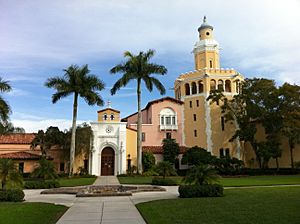
Schools for Kids and Teens
The Pinellas County School District serves the entire county. It is the 24th largest school district in the country. There are 143 schools, including elementary, middle, and high schools. The district also has special programs like International Baccalaureate (IB) programs and engineering programs.
Many private schools are also in the county. These include Admiral Farragut Academy and Shorecrest Preparatory School.
Colleges and Universities
Pinellas County has several colleges and universities. These include Eckerd College, the University of South Florida St. Petersburg, and St. Petersburg College. The Stetson University College of Law is in Gulfport.
Libraries for Everyone
The Pinellas Public Library Cooperative (PPLC) has 14 libraries. They work together to serve all areas of Pinellas County. This cooperative was started in 1989. It was the first countywide public library cooperative in Florida.
Pinellas County's Economy
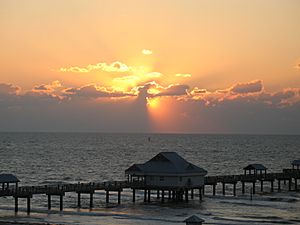
How the Economy Grew
In the early 1900s, farming was the most important industry in Pinellas. Growing citrus fruits was a big part of it. Raising cattle was also important. In 1885, a medical group said Pinellas was the "healthiest spot on earth." This helped bring many tourists to the area.
Today's Economy
Pinellas County has the second-largest number of manufacturing jobs in Florida. This is thanks to cities like Clearwater and St. Petersburg.
Pinellas has many different types of businesses that work well together. These include:
- Aviation and aerospace (things related to planes and space).
- Defense and national security.
- Medical technologies.
- Business and financial services.
- Information technology.
Big technology companies like Jabil Circuit and Tech Data have their main offices here. So does the financial company Raymond James Financial. Other large companies include HSN, Nielsen, and Valpak.
Service industries like healthcare, business services, and education provide over 200,000 jobs. They bring in almost $19 billion in money. Other big parts of the economy are retail (stores and restaurants) and finance (banks and insurance).
Culture and Fun in Pinellas County
Museums to Visit
Pinellas County has many interesting museums:
- Museum of Fine Arts in St. Petersburg.
- Salvador Dalí Museum in St. Petersburg, featuring the famous artist's work.
- The James Museum of Western & Wildlife Art in St. Petersburg.
- Florida Holocaust Museum in St. Petersburg.
- Morean Arts Center in St. Petersburg.
- Dr. Carter G. Woodson African American Museum in St. Petersburg.
- Leepa-Rattner Museum of Art in Tarpon Springs.
- Great Explorations Children's Museum in St. Petersburg, great for younger kids.
- Dunedin History Museum in Dunedin.
- Imagine Museum in St. Petersburg.
- Museum of the Arts and Crafts Movement (MAACM) in St. Petersburg.
- St. Petersburg Museum of History in St. Petersburg.
- Chihuly Collection in St. Petersburg, featuring glass art.
Places for Performances
You can enjoy live shows at these venues:
- Ruth Eckerd Hall in Clearwater.
- Mahaffey Theater in St. Petersburg.
- Jannus Landing in St. Petersburg.
- Palladium at St. Petersburg College in St. Petersburg.
- freeFall Theatre in St. Petersburg.
- American Stage in St. Petersburg.
- Studio@620 in St. Petersburg.
The Florida Orchestra performs at Ruth Eckerd Hall and the Mahaffey Theater. The Clearwater Jazz Holiday is a big music event held every October.
Other Cool Places to See
Older communities like Old Northeast in St. Petersburg and Harbor Oaks in Clearwater have beautiful old buildings.
Farmer's markets are very popular here. The Saturday Morning Market in St. Petersburg draws big crowds.
Downtown areas in St. Petersburg and Dunedin, and many beaches, especially Clearwater Beach, have lively nightlife.
Besides Heritage Village, there are other local history museums. These include the St. Petersburg Museum of History and the Dunedin History Museum. They show visitors what the area was like in the past.
Pinellas County has two botanical gardens: the Florida Botanical Gardens in Largo and Sunken Gardens in St. Petersburg.
Indian Shores is home to the Suncoast Seabird Sanctuary. It's a large hospital for wild birds. You can see many different bird species there for free.
On Clearwater Beach, you'll find the Clearwater Marine Aquarium. This place rescues and helps injured marine animals. Their most famous resident was Winter, a dolphin with a prosthetic tail. Winter was the star of the movie Dolphin Tale.
The Anclote Keys Light is a lighthouse built in 1887. It's on the south end of Anclote Key, off Tarpon Springs. It's the only working lighthouse in Pinellas County. You can only reach the island by private boat.
Dunedin is home to the Dunedin Brewery, Florida's oldest microbrewery.
Sports and Recreation
Sports Teams in the Area
The Tampa Bay area has three major professional sports teams. They all use "Tampa Bay" in their name because they represent the whole area.
- Baseball's Tampa Bay Rays play at Tropicana Field in St. Petersburg.
- Football's Tampa Bay Buccaneers and hockey's Tampa Bay Lightning play in nearby Tampa.
Two Major League Baseball teams come to Pinellas for spring training:
- The Philadelphia Phillies play in Clearwater.
- The Toronto Blue Jays play in Dunedin.
Minor League Baseball teams also play at these ballparks.
The Tampa Bay Rowdies soccer team plays at Al Lang Stadium in St. Petersburg.
The Honda Grand Prix of St. Petersburg is a car race held every spring in downtown St. Petersburg.
The PGA Tour golf tournament, Valspar Championship, happens every March in Palm Harbor.
Places for Fun and Activities
- Skyway Fishing Pier State Park: This is part of the old Sunshine Skyway Bridge. It's the longest fishing pier in the world.
- Fred Marquis Pinellas Trail: This is a 37-mile path for running and biking. It follows an old railroad line from Tarpon Springs to St. Petersburg.
Other popular fishing spots include Pier 60 on Clearwater Beach and the piers at Fort De Soto Park.
Pinellas County has many waterways for kayaking. These are called blueways. The county also has artificial reefs in the Gulf. These are great for fishing and scuba diving.
The county's two largest freshwater lakes are Lake Tarpon and Lake Seminole. They are popular for water skiing, jet-skiing, sailing, fishing, and kayaking.
Both the North Beach of Fort De Soto Park (in 2005) and Caladesi Island (in 2008) have been named America's Top Beach by "Dr. Beach."
Media and News
Pinellas County is part of the Tampa Bay area, which is a large television market. It has many local TV stations and cable channels. Over 70 radio stations also broadcast here.
The main daily newspapers are the Tampa Bay Times and The Tampa Tribune. The Times also gives out a free daily paper called tbt*. Creative Loafing Tampa is a popular alternative weekly newspaper.
Transportation in Pinellas County
Main Roads

 I-175 / SR 594
I-175 / SR 594
 I-275 / SR 93
I-275 / SR 93
 I-375 / SR 592
I-375 / SR 592 US 19
US 19


 US 19 Alt. / SR 595
US 19 Alt. / SR 595 US 92
US 92 SR 60
SR 60 SR 580
SR 580 SR 586
SR 586 SR 590
SR 590 SR 679
SR 679 SR 682
SR 682 SR 686
SR 686 SR 687
SR 687 SR 688
SR 688 SR 689
SR 689 SR 693
SR 693 SR 694
SR 694 SR 699
SR 699
Airports
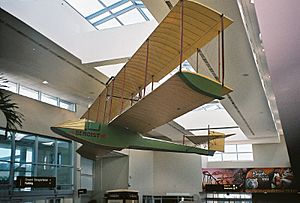
- St. Pete–Clearwater International Airport
- Albert Whitted Airport
- Clearwater Executive Airpark
- Tampa International Airport is across the bay in Tampa.
Trains
The CSX railroad company operates train lines in Pinellas County. These lines carry freight (goods). Regular passenger train service in Pinellas County ended in 1984. Some old train tracks have been turned into parts of the Pinellas Trail.
In 2012, there were ideas for a light rail system. This system would connect Clearwater, St. Petersburg, and Tampa. Voters would need to approve it.
Public Transportation
The Pinellas Suncoast Transit Authority (PSTA) runs 205 buses and trolleys. They cover 37 routes across the county. PSTA also has express routes to downtown Tampa. They connect with Tampa's bus system. In 2005–06, PSTA carried over 11 million passengers. The city of St. Pete also has a rapid bus service called the SunRunner.
Emergency Services
Fire Departments
Many cities and areas in Pinellas County have their own fire departments:
- Clearwater Fire Rescue
- Dunedin Fire Rescue
- East Lake Fire Rescue
- Gulfport Fire Rescue
- Largo Fire Rescue
- Lealman Fire District
- Maderia Beach Fire Rescue
- Oldsmar Fire Rescue
- Palm Harbor Fire Rescue
- Pinellas Park Fire Rescue
- Pinellas Suncoast Fire District
- Safety Harbor Fire Rescue
- Seminole Fire Rescue
- St. Pete Beach Fire Rescue
- St. Petersburg Fire Rescue
- South Pasadena Fire Rescue
- Tarpon Springs Fire Rescue
- Treasure Island Fire Rescue
Emergency Medical Services
- Sunstar Paramedics provides emergency medical services.
Law Enforcement Agencies
| Pinellas County Sheriff's Office | |
|---|---|
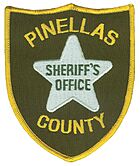
Patch of the Pinellas County Sheriff's Office
|
|
| Abbreviation | PCSO |
| Agency overview | |
| Formed | 1912 |
| Jurisdictional structure | |
| General nature | |
| Operational structure | |
| Headquarters | Largo, Florida |
| Agency executive |
|
| Website | |
| Pinellas County Sheriff's Office | |
The Pinellas County Sheriff's Office (PCSO) started in 1912. As of 2022, the sheriff is Bob Gualtieri. The Sheriff's Office provides police services to the county. They also help patrol these cities:
- Belleair Beach
- Belleair Bluffs
- Dunedin
- Indian Rocks Beach
- Madeira Beach
- North Redington Beach
- Oldsmar
- Redington Beach
- Safety Harbor
- Seminole
- South Pasadena
- St. Pete Beach
Many cities in the county have their own police departments:
- Belleair Police Department
- Clearwater Police Department
- Gulfport Police Department
- Indian Shores Police Department
- Kenneth City Police Department
- Largo Police Department
- Pinellas Park Police Department
- St. Petersburg Police Department
- Tarpon Springs Police Department
- Treasure Island Police Department
Hospitals
There are several hospitals in Pinellas and nearby counties.
Communities in Pinellas County
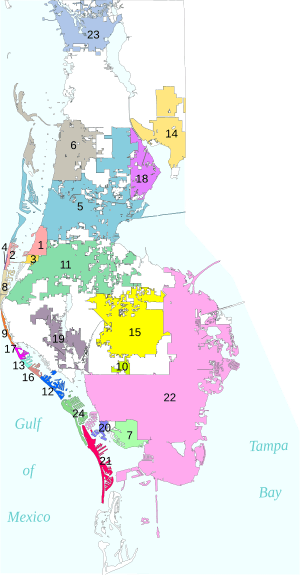
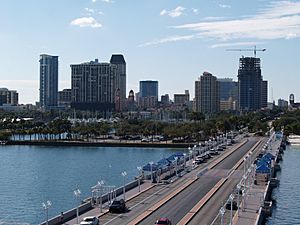
Cities
- Belleair Beach
- Belleair Bluffs
- Clearwater
- Dunedin
- Gulfport
- Indian Rocks Beach
- Largo
- Madeira Beach
- Oldsmar
- Pinellas Park
- Safety Harbor
- Seminole
- South Pasadena
- St. Pete Beach
- St. Petersburg
- Tarpon Springs
- Treasure Island
Towns
- Belleair
- Belleair Shore
- Indian Shores
- Kenneth City
- North Redington Beach
- Redington Beach
- Redington Shores
Census-Designated Places (CDPs)
These are areas that are not officially cities or towns, but are recognized for census purposes:
- Bardmoor
- Bay Pines
- Bear Creek
- East Lake
- Feather Sound
- Greenbriar
- Harbor Bluffs
- Lealman
- Palm Harbor
- Ridgecrest
- South Highpoint
- Tierra Verde
- West Lealman
Other Unincorporated Communities
These are smaller communities that are not part of any city or town:
- Baskin
- Crystal Beach
- Curlew
- Gandy
- Highpoint
- Innisbrook
- Oakhurst
- Ozona
- St. George
- Seminole Park
- Wall Springs
- Walsingham
See also
 In Spanish: Condado de Pinellas para niños
In Spanish: Condado de Pinellas para niños




